Florida is home to alligators, crocodiles, gigantic invasive pythons, panthers, and some of the most shark-infested waters in the world. So it’s no surprise people are curious just what are the most dangerous animals in the state. Let’s dive in to see everything from gigantic reptiles to venomous insects you need to be aware of when exploring Florida’s wilderness!

Are crocodiles and alligators the deadliest animals in Florida?
“Don’t worry the alligators are just like squirrels here!”
Um, I don’t think so! Some locals are used to cohabitating with alligators and crocodiles while visitors may be more leery. With the abundance of lakes, swamps, and the Everglades these reptiles are found throughout the state. In fact, it’s estimated that Florida’s alligator population stands at about 1.3 million. while there are about 2,000 crocodiles in the Everglades.
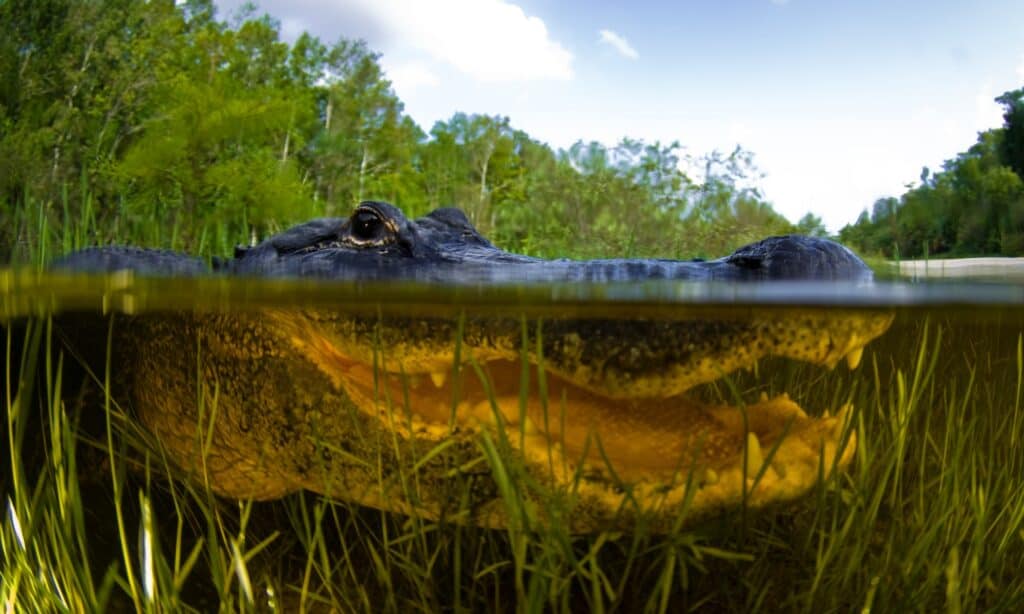
There are an estimated 1.3 million alligators in Florida.
©tswinner/Shutterstock.com
According to the Florida Fish and Wildlife Conservation Commission, there were around six documented bites a year between 1971 and 1986, and that has increased to an average of ten per year between 1987 and 2017. Although fatalities are extremely rare there have been 25 recorded fatalities due to alligator attacks in Florida since 1948.
One of the most recent deaths in Florida was this past summer over the 4th of July weekend, 2021. A woman was found dead in a retention pond near Tampa, FL, with her family stating that she often swam in that pond. Compared to the number of worldwide alligator/crocodile deaths, Florida is extremely safe, especially if a few rules are followed to remain safe such as staying out of the water in known alligator territory and abiding by posted restrictions. Across the world, there are an average of 1,000 crocodile-inflicted deaths annually, with many of these occurring in countries with sparse access to emergency healthcare.
How dangerous are the venomous snakes in Florida?
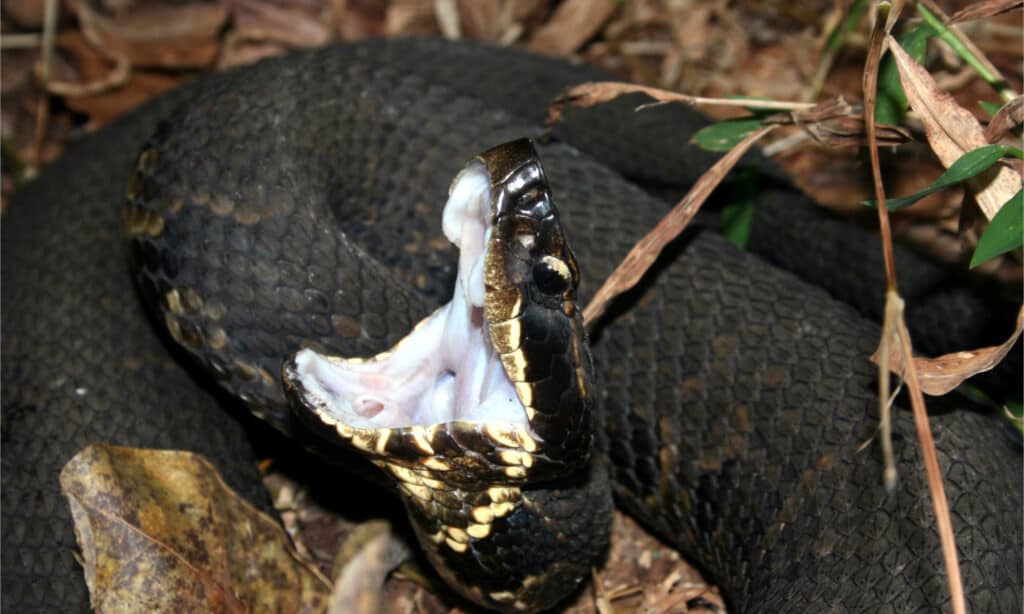
Cottonmouth snakes are one of six venomous snake species that can be found in Florida.
©Psychotic Nature/Shutterstock.com
Worldwide the average number of snake-related deaths is at least 50,000 per year! That number seems astronomical, but it is the reality. Here in the United States, we have access to antivenom and although we do have species such as timber rattlers and cottonmouths, these are not the most venomous snakes in the world.
Internationally, the “Big 4” snakes are responsible for an estimated 75% of snakebite fatalities. These snakes include Russell’s viper, common krait, Indian cobra, and saw-scaled viper. Each of these snakes lives in India where they come into contact with rapidly expanding urban areas with large populations.
In the US there are a reported 7,000-8,000 venomous snake bites a year but only 5 of those result in death. The number of kids bitten by snakes is much higher in Florida and Texas, in part due to the number of snakes in each state.
Florida has six venomous snakes within its borders: the eastern diamondback rattlesnake, timber rattlesnake, pygmy rattlesnake, cottonmouth, copperhead, and eastern coral snake. Recent snake bite deaths included a 2014 incident where a 4-year-old was bitten by a timber rattlesnake and two deaths in 2005 from a coral and eastern diamondback rattlesnake. Overall, most recorded snakebite deaths in Florida have come from eastern diamondbacks.
There are also 3 scorpions found in Florida that can produce painful stings but are generally not fatal. Florida is also home to the southern black widow and brown recluse, both of which have venom that can produce extremely painful bites.
What about other snakes, like the Burmese python, are these the deadliest?
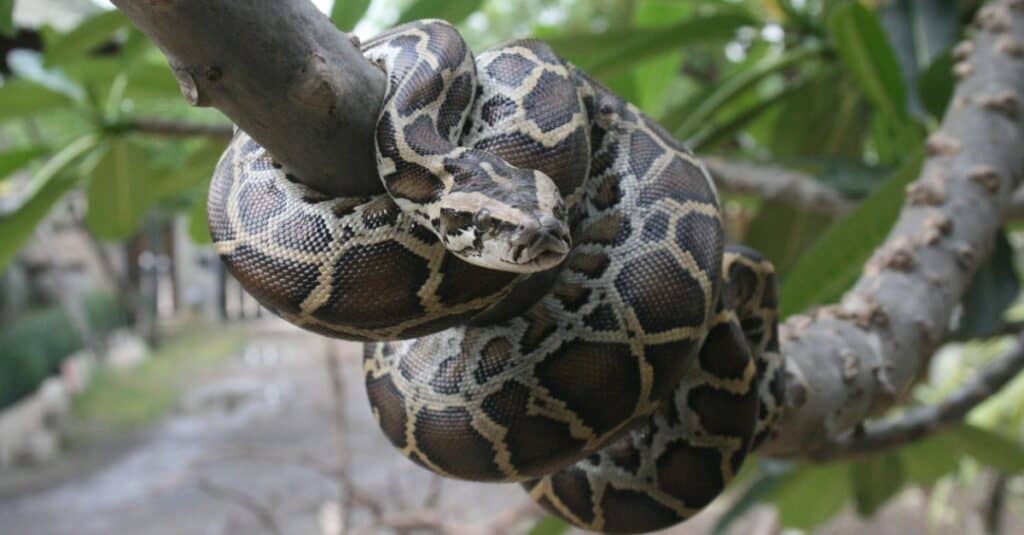
Some estimates of
Burmese python
populations in Florida reach over 100,000 snakes spread across the Everglades.
©iStock.com/Lunatic_67
Burmese pythons are not native to Florida but they do live here. Talk about big snakes, these are huge! They can grow to be 6-9 feet long with the longest one recorded in Florida reaching 18 feet! And they are not skinny little snakes, they are thick with some as thick around as a telephone pole. They are not venomous but may bite in self-defense.
Pythons are constrictors and kill their prey by wrapping around them until they can no longer breathe, then releasing them and eating them whole. According to the United States Geological Survey, there have not been any fatalities resulting from Burmese Pythons in Florida. Pets, like dogs and cats, have been victims of these giant snakes and they are considered an invasive species. If you see one you should report the sighting and get to safety as soon as possible.
What other deadly animals are there on land in Florida?
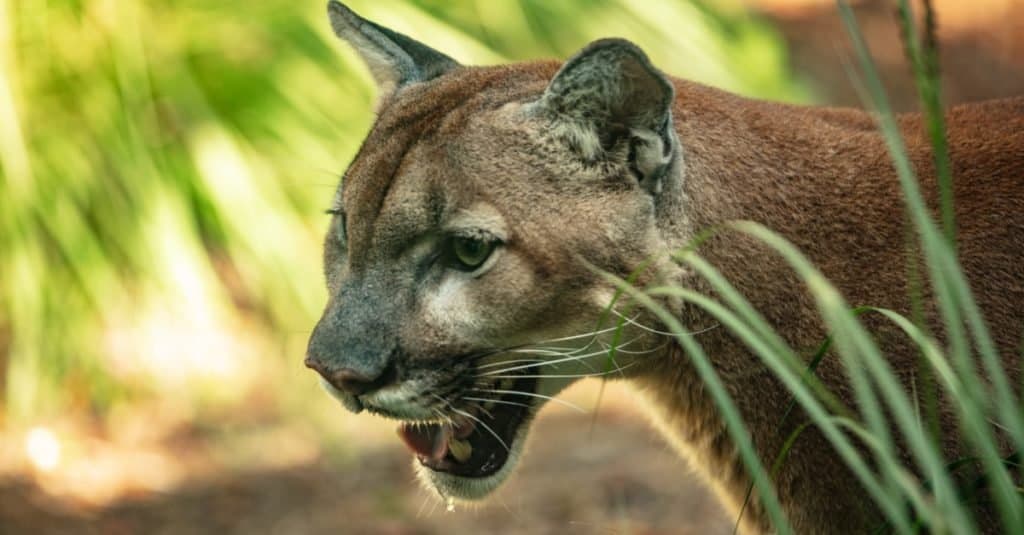
The Florida panther is a subspecies of the mountain
lion
.
©J.A. Dunbar/Shutterstock.com
The state animal is the Florida panther. These mountain lions can grow to be 60-160 lbs and are long at 5-7 feet. Because Florida panthers are endangered, it’s extremely rare that humans come into contact with them. They are listed as endangered and are protected in Florida, with 120-230 left in the wild. If you want a safe way to see one of these rare animals you can visit the Ellie Schiller Homosassa Springs Wildlife State Park.
What deadly animals are in the waters surrounding Florida?
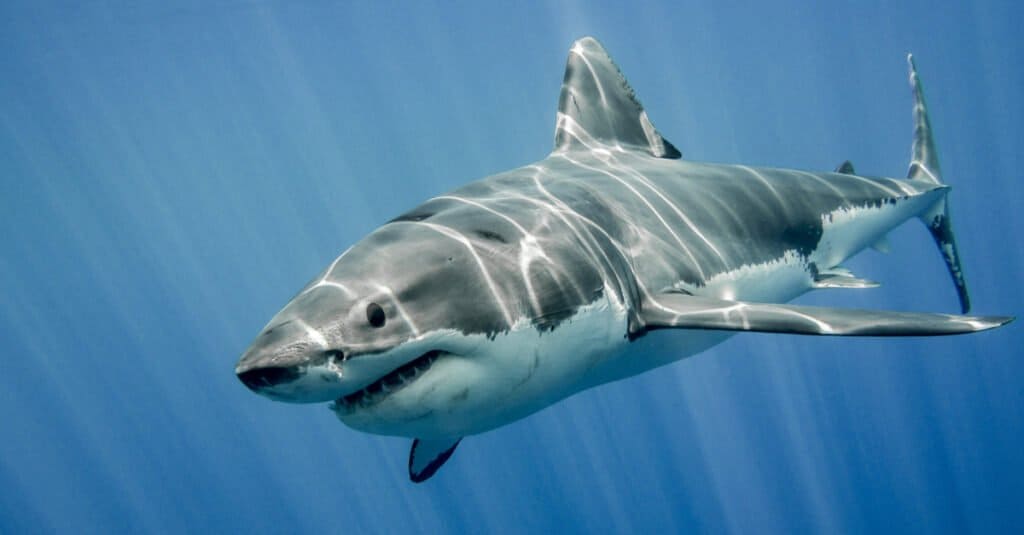
Great white sharks
have more unprovoked attacks than any other shark species.
©Ramon Carretero/Shutterstock.com
Florida is a peninsula with the Atlantic Ocean to the east and the Gulf of Mexico to the west. As soon as you think of dangerous ocean animals you probably think of sharks. But what about jellyfish? Let’s look at some of the dangerous marine animals in Florida:
- Sharks: There are Great White sharks that live off the coast of Florida, both in the Atlantic and the Gulf. Shark attacks, in general, are pretty rare but with the number of beaches in Florida and the number of beachgoers, it should not be a surprise that Florida has the highest number of shark attacks in the US. In 2020 Florida topped the list of shark bites with 16, and Hawaii came in second place with 5. Half of those attacks in Florida were in Volusia County. Most often sharks mistake surfers for seals and attack them thinking they are dinner. Globally there were only 11 shark-related fatalities in 2021, so statistically, it is highly unlikely to die from a shark.
- Jellyfish: Box jellyfish are known to be the deadliest jellyfish with venomous stingers that can cause a person to go into shock or have a heart attack. They are clear (which doesn’t help to spot them in the ocean) and can grow to be 10 feet long. There are no known deaths from jellyfish in Florida but worldwide there is an average of 40 per year. Other jellyfish species are less venomous but still provide a painful sting. Over a period of three days in 2018, 800 people were stung by jellyfish along the central Florida coast with a large group of moon jellyfish showing up. A spokesperson said that once or twice a year there is a high incidence of jellyfish due to the currents. Beachgoers can be aware of posted flags on the beach indicating certain risks like high tides or dangerous marine life, thus limiting their risks so they can enjoy the beautiful Florida beaches year-round.
Summary of the 10 Most Dangerous Animals in Florida
Now that we’ve dug deep into the dangers of Florida animals, here are the 10 most dangerous animals in the state:
| Rank | Dangerous Animal |
|---|---|
| 1 | Great White Shark |
| 2 | Bull Shark |
| 3 | Alligator |
| 4 | Eastern Diamondback Rattlesnake |
| 5 | Cottonmouth Snake |
| 6 | Black Widow |
| 7 | Florida Panther |
| 8 | Wild Boar |
| 9 | Timber Rattlesnake |
| 10 | American Crocodile |
Honorable Mentions: Other Deadly Animals in Florida
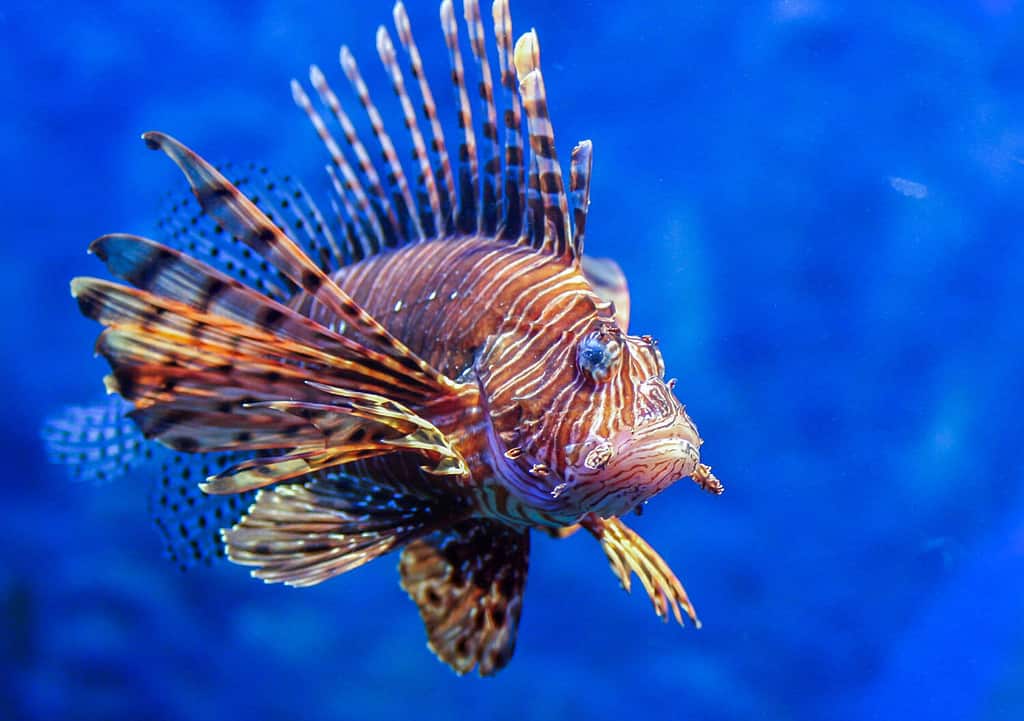
The invasive
lionfish
was introduced into Florida waters in the 1980s and now poses a threat to marine life.
©dimakig/Shutterstock.com
And the list goes on…Here are a few more dangerous animals to keep a sharp lookout for in the great state of Florida and its surrounding waters:
- Florida Harvester Ant (Pogonomyrmex badius) Not only do harvester ants attack humans and small animals, but they leave their stingers in at the point of the sting. Their stings are painful and capable of causing allergic reactions even to the point of anaphylactic shock.
- Lionfish (Pterois) Lionfish are an invasive species of fish that was introduced into Florida waters. Besides being a threat to other sea life, their venomous spines can cause intense pain, nausea, and even allergic reactions in humans that may be stung.
- Guiana Striped Scorpion (Centruroides guianensis) This scorpion, along with the Hentz scorpion, is one of the most dangerous animals in Florida. Its venom affects the central nervous system, paralyzes muscles, and can even be deadly.
- Southern Copperhead (Agkistrodon contortrix) One more venomous snake to add to our list of dangerous animals would be the copperhead, whose bite causes symptoms like swelling, pain, and tissue damage.
The photo featured at the top of this post is © GoodFocused/Shutterstock.com
Thank you for reading! Have some feedback for us? Contact the AZ Animals editorial team.






